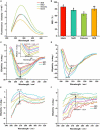Formation mechanism and functional properties of walnut protein isolate and soy protein isolate nanoparticles using the pH-cycle technology
- PMID: 36845052
- PMCID: PMC9950265
- DOI: 10.3389/fnut.2023.1135048
Formation mechanism and functional properties of walnut protein isolate and soy protein isolate nanoparticles using the pH-cycle technology
Abstract
Walnut protein isolate (WPI) is a nutritious protein with poor solubility, which severely limits its application. In this study, composite nanoparticles were prepared from WPI and soy protein isolate (SPI) using the pH-cycle technology. The WPI solubility increased from 12.64 to 88.53% with a WPI: SPI ratio increased from 1: 0.01 to 1: 1. Morphological and structural analyses illustrated that interaction forces with hydrogen bonding as the main effect jointly drive the binding of WPI to SPI and that protein co-folding occurs during the neutralization process, resulting in a hydrophilic rigid structure. In addition, the interfacial characterization showed that the composite nanoparticle with a large surface charge enhanced the affinity with water molecules, prevented protein aggregation, and protected the new hydrophilic structure from damage. All these parameters helped to maintain the stability of the composite nanoparticles in a neutral environment. Amino acid analysis, emulsification capacity, foaming, and stability analysis showed that the prepared WPI-based nanoparticles exhibited good nutritional and functional properties. Overall, this study could provide a technical reference for the value-added use of WPI and an alternative strategy for delivering natural food ingredients.
Keywords: functional properties; interaction; nanoparticles; pH-cycle; soy protein isolate; walnut protein isolate.
Copyright © 2023 Dai, Xu, Shi, Liu and Bi.
Conflict of interest statement
The authors declare that the research was conducted in the absence of any commercial or financial relationships that could be construed as a potential conflict of interest.
Figures







Similar articles
-
Effect of pH-Shifted Compound Heating Treatment on the Structure and Properties of Walnut Protein Isolate.Foods. 2025 May 15;14(10):1754. doi: 10.3390/foods14101754. Foods. 2025. PMID: 40428533 Free PMC article.
-
Preparation and Properties of Walnut Protein Isolate-Whey Protein Isolate Nanoparticles Stabilizing High Internal Phase Pickering Emulsions.Foods. 2024 Jul 28;13(15):2389. doi: 10.3390/foods13152389. Foods. 2024. PMID: 39123580 Free PMC article.
-
The formation of protein coronas and the interaction of soy protein isolate and whey protein isolate with starch nanoparticles.Int J Biol Macromol. 2024 Dec;282(Pt 6):137451. doi: 10.1016/j.ijbiomac.2024.137451. Epub 2024 Nov 8. Int J Biol Macromol. 2024. PMID: 39522901
-
Structural and foaming properties of whey and soy protein isolates in mixed systems before and after heat treatment.Food Sci Technol Int. 2022 Sep;28(6):545-553. doi: 10.1177/10820132211031756. Epub 2021 Jul 7. Food Sci Technol Int. 2022. PMID: 34233546
-
Preparation, characterization, and binding mechanism of pH-driven gliadin/soy protein isolate nanoparticles.Food Res Int. 2025 May;208:116289. doi: 10.1016/j.foodres.2025.116289. Epub 2025 Mar 16. Food Res Int. 2025. PMID: 40263867
Cited by
-
Effect of pH-Shifted Compound Heating Treatment on the Structure and Properties of Walnut Protein Isolate.Foods. 2025 May 15;14(10):1754. doi: 10.3390/foods14101754. Foods. 2025. PMID: 40428533 Free PMC article.
-
Investigating the impact of ultrasound-assisted treatment on the crafting of mulberry leaf protein and whey isolate complex: A comprehensive analysis of structure and functionality.Ultrason Sonochem. 2024 Aug;108:106983. doi: 10.1016/j.ultsonch.2024.106983. Epub 2024 Jul 8. Ultrason Sonochem. 2024. PMID: 39002225 Free PMC article.
References
LinkOut - more resources
Full Text Sources

